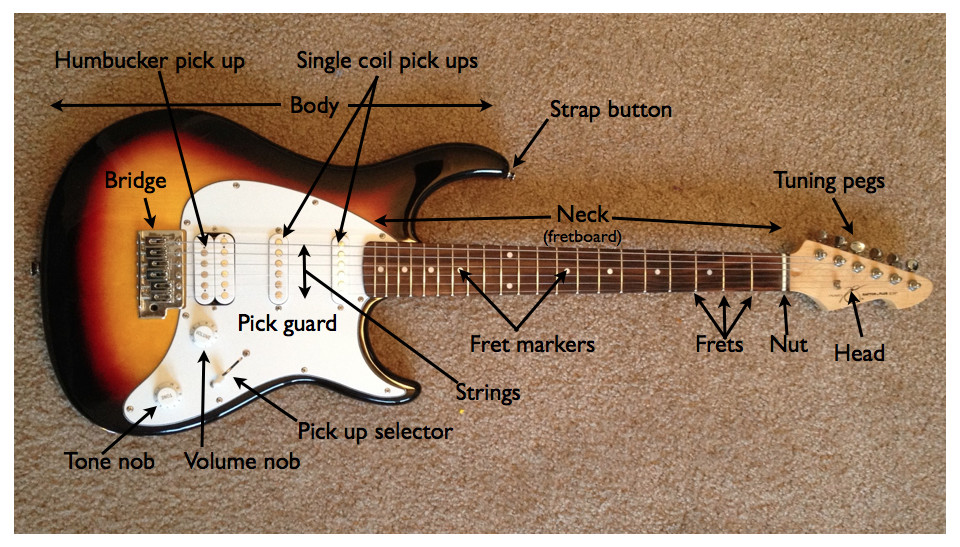The parts of the electric guitar are the same as the acoustic guitar with a few additional things to learn.

Body– Unlike an acoustic guitar, the body of an electric guitar is usually made of a solid piece of wood. There is a lot of variety in wood choices but the most common are: Ash, Alder, Mahogany and Maple.
- Pick ups– Since the electric guitar is not hollow it needs something to pick up the sound of of the strings and send it to the amplifier for producing an audible sound. This is the job of the pick ups. They are constructed of a magnet wound with a fine wire filament. There are 2 common types of pick ups: single coil and humbucker pickups (see above).
- Pick up selector– most electric guitars have more than one pick up. The selector chooses which pick up or combination of pick ups are active.
- Bridge– The bridge is attached the body and serves to hold one end of the 6 guitar strings. It is also one of the two fulcrum points that the strings rest on. The other is the nut.
- Tone nob– This adjusts how bright or dark the sound of your guitar is going to the amp. All the way up is bright and all the way down is dark or more muffled sounding.
- Volume nob– Adjust the volume of the signal being sent to the amplifier.
- Strap buttons– These are little pegs drilled into the body for holding your strap. There are usually 2: one in the area where the neck meets the body and another on the bottom of the body.
Neck– The neck is where you put your fingers in order to play melodies and chords. Different notes are produce by pressing the strings down into the fret wires at different points along its length.
- Fret(s)– Frets are the thin metal bars place along the neck in decreasing intervals. They serve as markers for where all the notes occur on the guitar. Notice how the distance between them get smaller as you move towards the body. The notes get higher in pitch as you move towards the body and lower as you move away from it.
- Fretboard– The fretboard is the name we use for the front plane of the neck where all the frets are.
- Nut– The is one of the fulcrum points where the strings rest up by the head of the guitar. The other is the bridge.
- Strings– The strings are the long metal wires of increasing thicknesses that run along the guitar from top to bottom. They are where sound is first produced. The strings are pressed into the neck at different points along their length in order to create different notes. Guitars most commonly have 6 strings although there are also 12 and 7 string guitars as well.
Head– The head is one of the ends where the strings are tied; the bridge being the other. It is always angled back away from the neck so that the when the strings are tightened they will stay seated down firmly into the nut.
- Tuning pegs– Located on the head, the tuners or tuning pegs are used to tune the strings to their proper pitch. They consist of a metal tower with a hole in it for tying the string and a peg attached to a gear for raising or lowering the pitch.
Next Lesson: How to hold a guitar the right way
 Copyright secured by Digiprove © 2014 jeff lauffer
Copyright secured by Digiprove © 2014 jeff lauffer 
Leave a Reply